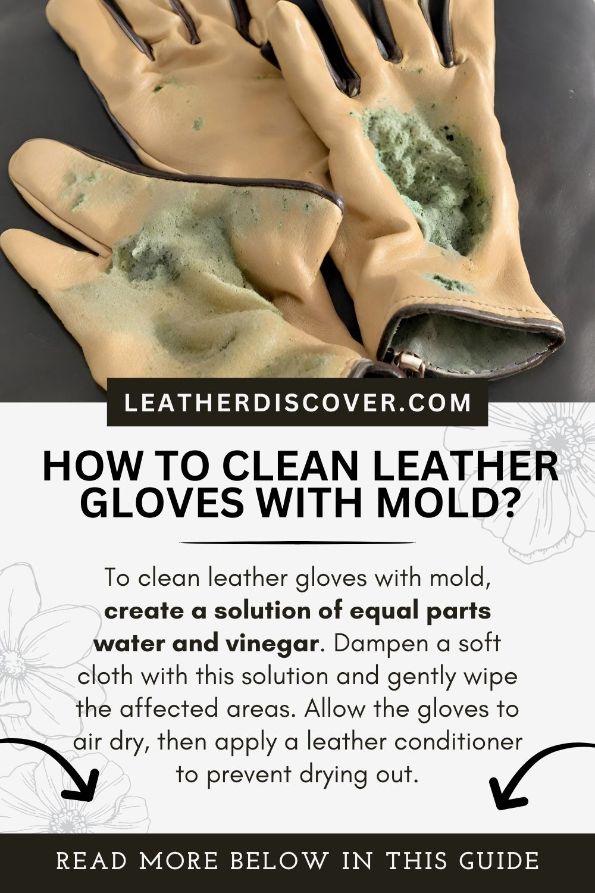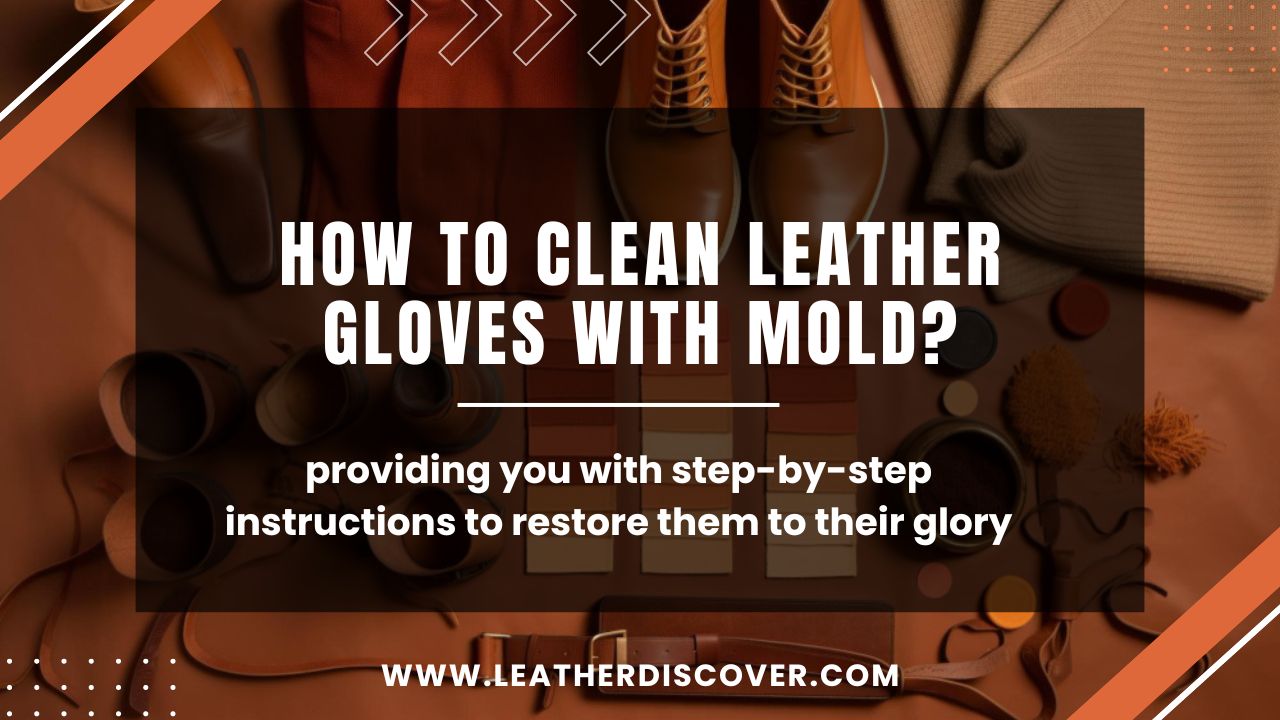Cleaning leather gloves that have developed mold can be a daunting task, as it requires a delicate touch to ensure the leather remains unharmed during the cleaning process. Mold not only mars the aesthetic appeal of these cherished accessories but can also compromise their durability.
Whether your leather gloves are exposed to excessive moisture, stored in a damp environment, or have been overlooked for some time, effectively addressing mold is crucial.
In this guide, we will explore various methods on how to clean leather gloves with mold, providing you with step-by-step instructions to restore them to their former glory.
[toc]

How to Clean Leather Gloves With Mold?
Here are four different methods on how to clean leather gloves with mold:
| Method | Materials Needed | Steps |
|---|---|---|
| Mild Soap and Water | – Mild soap – Warm water – Soft cloth or sponge – Towel – Leather conditioner (optional) |
1. Spot Test: Test a small, inconspicuous area to check for colorfastness. 2. Mix a small amount of mild soap with warm water to create a soapy solution. 3. Gently wipe the moldy areas of the gloves with a damp cloth or sponge. 4. Rinse and pat dry with a towel. 5. Allow gloves to air dry at room temperature. 6. Condition the leather if desired. |
| White Vinegar Solution | – White vinegar – Water – Soft cloth – Towel – Leather conditioner (optional) |
1. Spot Test: Test a small, inconspicuous area to check for colorfastness. 2. Mix equal parts white vinegar and water to create a mild cleaning solution. 3. Gently wipe the moldy areas of the gloves with a damp cloth. 4. Wipe off any excess solution with a clean, damp cloth. 5. Follow the drying and conditioning steps if needed. |
| Rubbing Alcohol | – Rubbing alcohol (isopropyl alcohol) – Soft cloth – Towel – Leather conditioner (optional) |
1. Test an inconspicuous area to ensure the alcohol won’t damage the leather. 2. Dampen a soft cloth with rubbing alcohol. 3. Gently rub the moldy areas of the gloves. 4. Wipe off any residue with a clean, damp cloth. 5. Allow the gloves to air dry. 6. Optionally, apply leather conditioner after they are dry. |
| Baking Soda | – Baking soda – Soft cloth – Towel |
1. Dust the moldy areas of the gloves with a thin layer of baking soda. 2. Leave the gloves in a dry, well-ventilated area for several hours or overnight. 3. Gently brush off the baking soda. 4. Wipe the gloves with a damp cloth to remove any remaining residue. 5. Allow the gloves to air dry completely. |
This chart broadly explains which methods to consider if you are wondering how to clean leather gloves with mold.
Remember that preventing mold in the first place by storing leather gloves in a dry and well-ventilated area is the best practice.
Always test any cleaning method on a small, inconspicuous area of the gloves before treating the entire surface to avoid potential damage.
What Causes Mold on Leather?
Mold on leather can develop when the material is exposed to high levels of moisture and humidity. The key factors contributing to mold growth on leather are:
- Moisture: Excessive moisture in the environment or direct contact with water can create a breeding ground for mold on leather.
- Humidity: High humidity levels, especially in poorly ventilated spaces, can promote mold growth on leather items.
- Darkness: Mold spores thrive in dark environments, and leather goods stored in dark, damp places are more susceptible to mold growth.
- Lack of Air Circulation: Insufficient air circulation can prevent moisture from evaporating, allowing mold to develop on the leather’s surface.
- Dirt and Organic Matter: Dust, dirt, and organic substances on the leather can provide nutrients for mold, facilitating its growth.
What Is the Best Mold Remover for Leather?
The best mold remover for leather is a mild and natural solution that won’t harm the leather.
As mentioned earlier, a mixture of equal parts white vinegar and water is effective at removing mold from leather. Additionally, you can use specialized leather cleaners designed to tackle mold and mildew.
When using any mold remover, always perform a spot test on an inconspicuous area of the leather to ensure it won’t discolor or damage the material.
Can Leather Mold Spread?
Yes, leather mold can spread if the conditions that caused its growth persist. Mold spores are highly resilient and can become airborne, potentially contaminating other leather items or surfaces in your home. To prevent the spread of mold:
- Isolate the affected leather item to prevent cross-contamination.
- Clean and treat the mold as soon as possible to stop it from spreading further.
- Address the underlying cause of moisture or humidity that led to mold growth to prevent future outbreaks.
How to Store Leather Goods?
Store leather gloves in a cool, dry place away from direct sunlight and heat sources.
Avoid cramming them tightly, and consider using breathable storage bags or containers to protect them from dust and moisture.
Additionally, maintain their shape by using appropriate supports, like glove inserts or lightly stuffing them with acid-free tissue paper.
How to care for leather gloves?
Here’s how to care for leather gloves:
1. Clean Regularly:
Gently wipe the surface of your gloves with a clean, dry cloth after each use to remove dirt and sweat.
2. Deep Cleaning:
- For more thorough cleaning, use a mild leather cleaner or a mixture of mild soap and water.
- Dampen a soft cloth with the cleaning solution and wipe the gloves. Avoid soaking the leather.
- Rinse the cloth and wipe off any soap residue.
- Let the gloves air dry at room temperature. Avoid heat sources or direct sunlight, which can cause the leather to crack.
3. Conditioning:
- Apply a leather conditioner specifically designed for gloves. This helps maintain the leather’s suppleness and prevents it from drying out or becoming brittle.
- Follow the manufacturer’s instructions for the conditioner.
4. Storage:
- Store your gloves in a cool, dry place, away from direct sunlight and heat sources.
- Avoid tightly cramming them, as this can deform the leather.
- Use glove inserts or lightly stuff them with acid-free tissue paper to help maintain their shape.
5. Avoid Excessive Moisture:
Don’t wear leather gloves in heavy rain, and if they get wet, let them air dry naturally. Avoid using direct heat sources like hairdryers.
6. Protect from Stains:
Be cautious when handling staining substances like ink, oil, or food. If a stain occurs, consult a professional leather cleaner for guidance.
7. Regular Inspection:
Periodically check your gloves for signs of wear, loose stitching, or damage. Address any issues promptly to prevent further deterioration.
8. Rotate Use:
If you have multiple pairs of leather gloves, rotate their use to prevent excessive wear on a single pair.
By following these care instructions, you can keep your leather gloves in excellent condition, ensuring they remain comfortable, stylish, and functional for years to come.
Conclusion:
So, now you know how to clean leather gloves with mold.
The process of cleaning leather gloves with mold requires a delicate touch and attention to detail to restore these cherished accessories to their former glory.
Utilizing natural methods like a vinegar solution ensures effective mold removal while safeguarding the integrity of the leather. Regular maintenance and preventive measures, such as proper storage and climate control, play a vital role in preventing mold from recurring.
With care and patience, it’s possible to enjoy clean, mold-free leather gloves that not only look great but also stand the test of time, ensuring both style and functionality.
- What Is Caiman Leather? A Detailed Guide - July 25, 2024
- What Is Tumbled Leather?A Complete Guide - July 25, 2024
- What Is Kip Leather? Premium Leather Choice - July 24, 2024

